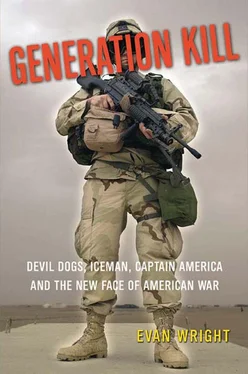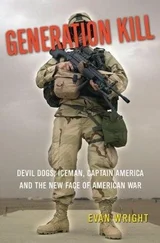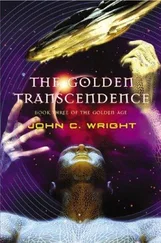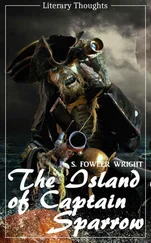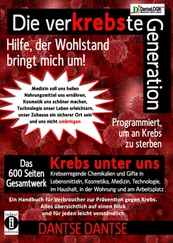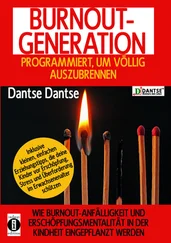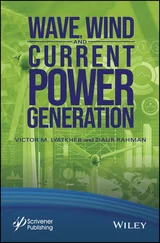We roll onto the darkened road, heading toward the bridge at about twenty-five miles per hour. Far up ahead, we see headlights from a lone vehicle moving down perpendicular to the road we’re on. It reaches the approximate location of the bridge and the lights go off. Colbert is watching this, debating its meaning: Some farmer driving at night toward a bridge that’s been pounded with artillery for several hours? Fedayeen sending up reinforcements or using the headlights to signal someone?
The team ceases its speculation when Cobras thump overhead. They fire multiple volleys of zuni rockets, striping the sky in front of us with white burn trails that culminate in multiple explosions near the bridge. We make out trees—not palms but spiky eucalyptus trees—silhouetted in the light of the bursting rockets.
Cobra pilots radio down to Maj. Shoup that their thermal-imagining devices are picking up “blobs”—possible heat signatures of people—hiding amidst the eucalyptus trees by the foot of the bridge. The pilots tried hitting them with their zunis, but the rockets overshot the trees. Now they’re concerned about firing any more for fear of hitting the Marines approaching on the ground. Due to a comms error in the battalion, none of this information is passed to Colbert, Fick or anyone else in the platoon.
Colbert orders Person to continue driving into the direction of the explosions. Everyone’s life depends on Person. He’s the only one inside the Humvee with NVGs on, allowing him to see the road ahead. He hunches forward over the steering wheel, his face obscured by the apparatus. The NVGs give their wearer a bright gray-green view of the night and offer a limited, tunnel-vision perspective but no depth perception. Person is having trouble finding the bridge. It’s not quite where the map indicated it would be. Colbert radios this news to Fick.
He radios back, “Not good. Not good.”
Then Person figures out that reaching the bridge requires a sharper right turn than he’d thought. He makes it. “There’s an obstacle on the bridge,” Person says in a dull monotone that nevertheless manages to sound urgent.
“What?” asks Colbert. He has night-vision capabilities on his rifle scope but in the cramped Humvee can’t turn it forward to see what Person is looking at.
“It’s like a shipping container,” Person says. “In the middle of the road.”
It’s actually a blown-up truck turned sideways on the road several meters before the entrance to the bridge. We stop about twenty meters in front of it. To the left is that stand of tall eucalyptus trees. They’re about five meters from the edge of the road. Behind us, there’s a large segment of drainpipe that’s been dragged across part of the road.
Person drove around the pipe a moment ago. Through his NVGs it had appeared to be a small trench in the road—what he’d thought was the result of natural erosion. Now the team behind us is radioing, “You guys just drove around a pipe.”
It’s becoming clear to the team that this is not random debris. The pipe and the ruined truck in front of us were deliberately placed where they are in order to channel the vehicle into what is known in military terms as a “kill zone.” We are sitting in the middle of it.
Everyone in the Humvee (except me) has figured this out. The men remain extremely calm. “Turn the vehicle around,” Colbert says softly. The problem is, the rest of the convoy has continued pushing into the kill zone behind us. All five Humvees in the platoon are bunched together, with twenty more pressing from behind. Person gets the Humvee partially turned around; the eucalyptus trees are now on our immediate right. But the pipe, which was behind us, now prevents the Humvee from moving forward.
Person guns the engine, starting into a sharp turn, intending to cut around the pipe by going off the road.
“Halt! Stop it,” Colbert says. “Don’t go off the road. It could be mined. We’ve got to go out the way we came in.”
Colbert radios the rest of the platoon, telling them to back the fuck up, while simultaneously peering out his window through his night-vision rifle scope.
“There are people in the trees,” he says, no trace of alarm in his voice. He repeats the message over his radio, hunches more tightly over his rifle and begins shooting.
His first shot kicks off an explosion of gunfire. There are between five and ten enemy fighters crouched beneath the trees—just five meters from the edge of our Humvee. There are several more across the bridge in bunkers, manning a belt-fed machine gun and other weapons, and still more ambushers on the other side of the road with RPGs. They have the Marines surrounded on three sides, raking the kill zone with rifle and machine-gun fire and RPGs.
Why they did not start shooting first is a mystery. Colbert believes, he later tells me, that they simply didn’t understand the capabilities of American night-vision optics. The Marine rifles have night-vision scopes wedded to laser target designators—a little infrared beam that goes out and lights up the spot where the bullet will hit. Since it’s infrared, the dot can only be seen through a night-vision scope or NVGs. What each Marine sees is not only his own laser dot lighting up a target, but those emitted by his buddies’ weapons as well. The effect is sort of like a one-sided game of laser tag.
Now, in the kill zone, Marines looking through their scopes are seeing the heads and torsos of enemy fighters lit up by two or three laser dots at once, as they pick them off tag-team style, carefully transitioning from target to target. The Marines have to be careful. Their advantage in night optics is precarious. Bunched up as they are together, if they start shooting wildly, they risk killing one another. The other problem is, while the Marines are getting in good shots, their vehicles are so jammed up, no one’s able to move out.
Fick can feel his truck jolting as enemy rounds rip through the sheet-metal sides. Through his window, he sees muzzles spitting flames in the darkness like a bunch of camera flashes going off at once. Then he sees an RPG streak right over the rear hatch of Colbert’s Humvee and explode. He decides to jump out of his vehicle and try to direct the Humvees out of the kill zone. Fick’s own coping mechanism for combat is what he calls the “Dead Man Walking Method.” Instead of reassuring himself, as some do, that he’s invincible or that his fate is in God’s hands (which wouldn’t work for him since he leans toward agnosticism), he operates on the assumption that he’s already a dead man, so getting shot makes no difference. This is the mode he’s in when he hops out of his Humvee, armed only with his 9mm pistol, and strides into the melee. Marines on Humvees shoot past his head while low-enfilade rounds from the enemy machine gun across the bridge skip past his feet. To the Marines seeing him approach, their lieutenant almost appears to be dancing. Fick later says he felt like he was in a shoot-out from The Matrix.
In our vehicle, Colbert seems to have entered a private realm. He fires bursts and, for some inexplicable reason, hums “Sundown,” the depressing 1970s Gordon Lightfoot anthem. His M-4 jams repeatedly, but each time he calmly clears the chamber and resumes firing, while mumbling the chorus: “Sometimes I think it’s a sin/When I feel like I’m winnin’ when I’m losin’ again.”
Meanwhile, Person, frustrated by the traffic jam, opens his door and, with shots crackling all around, shouts, “Would you back the fuck up!” In the heat of battle, his Missouri accent comes out extra hick. He repeats himself and climbs back in, his movements almost lackadaisical.
Two Marines are hit in the first couple of minutes of shooting. Q-tip Stafford is knocked down in the back of Fick’s truck by a piece of shrapnel to his leg. He ties his leg off with a tourniquet, gets back up and continues firing.
Читать дальше
